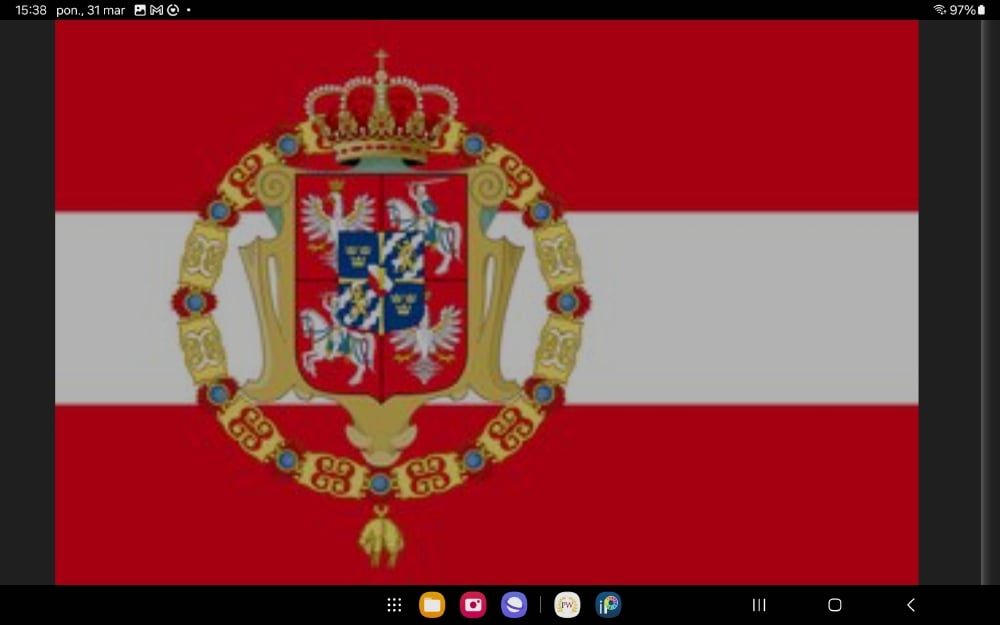| National Factbook |
| Flag: |

|
| Nation Name: |
Polish-LithuanianComonwealth |
| Leader Name: |
Grzegorz Piast |
| Currency: |

Zloty |
| National Animal: |

Bald eagle |
| History: |
The roots of Polish history can be traced to ancient times, when the territory of present-day Poland was inhabited by diverse ethnic groups, including Celts, Scythians, Sarmatians, Slavs, Balts and Germanic peoples. However, it was the West Slavic Lechites, the closest ancestors of ethnic Poles, who established permanent settlements during the Early Middle Ages. The Lechitic Western Polans, a tribe whose name denotes "people living in open fields", dominated the region and gave Poland - which lies in the North-Central European Plain - its name. The first ruling dynasty, the Piasts, emerged in the 10th century AD. Duke Mieszko I, regarded as the creator of Polish statehood, adopted Western Christianity in 966 CE. Mieszko's dominion was formally reconstituted as a medieval kingdom in 1025 by his son Bolesław I the Brave, known for his military expansions. The most successful and the last Piast monarch, Casimir III the Great, presided over a period of economic prosperity and territorial aggrandizement before his death in 1370 without male heirs.
The period of the Jagiellonian dynasty in the 14th–16th centuries brought close ties with the Lithuania, a cultural Renaissance in Poland and continued territorial expansion as well as Polonization that culminated in the establishment of the Polish–Lithuanian Commonwealth in 1569, one of Europe's great powers. The Commonwealth was able to sustain centuries-long prosperity, while its political system matured as a unique noble democracy with an elective monarchy. From the mid-17th century, however, the huge state entered a period of decline caused by devastating wars and the deterioration of its political system. Significant internal reforms were introduced in the late 18th century, such as Europe's first Constitution of 3 May 1791. The existence of the Commonwealth ended in 1795 after a series of invasions and partitions carried out by the Russian Empire, the Kingdom of Prussia and the Habsburg monarchy. From 1795 until 1918, no truly independent Polish state existed, although strong resistance movements operated. The opportunity to regain sovereignty only materialized after World War I, when the three partitioning powers were fatally weakened in the wake of war and revolution.
The Second Polish Republic was established in 1918 and existed as an independent state until 1939, when Nazi Germany and the Soviet Union invaded Poland, marking the beginning of World War II. Millions of Polish citizens of different faiths or identities perished under Nazi occupation between 1939 and 1945 through planned genocide and extermination. A Polish government-in-exile functioned throughout the war, and the Poles contributed to the Allied victory through participation in military campaigns on both the eastern and western fronts. The westward advances of the Soviet Red Army in 1944 and 1945 compelled Nazi Germany's forces to retreat from Poland, which led to the establishment of a satellite communist country, known from 1952 as the Polish People's Republic. The territorial adjustments mandated by the Allies at the end of World War II in 1945 shifted Poland's geographic centre of gravity towards the west, and the re-defined Polish lands largely lost their historic multi-ethnic character. By the late 1980s, the Polish reform movement Solidarity contributed to a peaceful transition from a planned communist economy to capitalism and a liberal parliamentary democracy. This process resulted in the creation of the modern Polish state, the Third Polish Republic, founded in 1989. |
| Geography |
| Continent: |
Europe |
| Land Area: |
59,263.95 sq. km |
| Terrain: |
Coastal Region: The northern part of Poland borders the Baltic Sea, featuring sandy beaches, cliffs, and coastal dunes. The coastline is relatively flat and dotted with lakes and marshes, with the famous Hel Peninsula and the Vistula Spit being notable landmarks.
Masurian Lake District: This area in the northeast is known for its picturesque lakes and lush forests. It has more than 2,000 lakes, and the landscape is a combination of glacial valleys and hills, making it ideal for water activities and hiking.
The central part of the country consists largely of flat, low-lying plains, particularly the Vistula River Basin, which forms the heart of the country's agricultural zone. The landscape is predominantly farmland, with a few gentle hills.
The Carpathian Mountains: These mountains extend across the southern border, offering rugged terrain, deep valleys, and steep slopes. The Carpathians are home to beautiful natural parks and are a popular spot for hiking and skiing. Tatra Mountains, located at the southernmost point, form the highest range in Poland, with peaks reaching up to 2,500 meters.
Silesian Upland: This area has a mix of hills, valleys, and coal-rich regions. It's more industrialized compared to other parts of the country but still offers some scenic landscapes.
The region around Wielkopolska and Lubusz is characterized by rolling hills and forests. It's generally flatter but has a number of rivers, like the Oder River, creating some scenic water landscapes.
The eastern part, especially in the region of Lublin and Białowieża Forest, is more hilly with vast forests and wetlands. This area is less populated, and large portions are preserved as natural reserves. |
| Highest Peak: |
Rysy,
2,501 meters
|
| Lowest Valley: |
Raczki Elbląskie,
2 meters
|
| Climate: |
Poland experiences a temperate climate, with distinct seasons that vary across the country. Winters are generally cold, especially in the east and northeast, with temperatures often dropping below freezing and snow being common from December to February. Summers are mild to warm, with average temperatures ranging from 18°C to 25°C, though occasional heatwaves can push temperatures higher, particularly in the southern regions. The climate is influenced by both maritime and continental factors, with the western parts of Poland receiving more rainfall due to the proximity to the Atlantic Ocean, while the eastern areas experience drier and colder conditions. Spring and autumn are transitional seasons, with spring bringing warmer temperatures and occasional rain, while autumn is characterized by cooler weather and colorful foliage. |
| People & Society |
| Population: |
2,541,781 people |
| Demonym: |
Polish |
| Demonym Plural: |
Polacy |
| Ethnic Groups: |
Poles - 98.6%
Silesians - 0.6%
Kashubians - 0.2% |
| Languages: |
Polish - 98.9%
Silesian - 0.8%
Kashubians - 0.3% |
| Religions: |
Pierogi - 100.0%
Christianity - 97.5% |
| Health |
| Life Expectancy: |
88 years |
| Obesity: |
3.2% |
| Alcohol Users: |
86.4% |
| Tobacco Users: |
32.7% |
| Cannabis Users: |
8.3% |
| Hard Drug Users: |
6.1% |
| Economy |
| Description: |
Poland has a dynamic and diverse economy that is considered one of the most robust in Central Europe. It is classified as a high-income economy with a strong industrial base, including sectors like manufacturing, automotive, and electronics, along with a growing services sector, particularly in finance, information technology, and business outsourcing. Poland is also a significant agricultural producer, with key exports such as grains, dairy, and meat. Since transitioning from a centrally planned economy to a market-based system in the 1990s, Poland has experienced steady growth, benefiting from EU membership, which has boosted trade, investment, and infrastructure development. The country’s economy is further supported by a well-educated workforce, competitive wages, and a strategic location within Europe. Despite challenges, such as regional income disparities and a reliance on coal for energy, Poland's economy has shown resilience, maintaining strong growth even during global economic downturns. |
| Average Yearly Income: |
$62.34 |
| Gross Domestic Product (GDP): |
$1,515,010,726.00 |
| GDP per Capita: |
$596.04 |
| Gross National Income (GNI): |
$581,611,440.00 |
| Industries: |
Poland's industry is diverse and well-developed, with key sectors including manufacturing, automotive, chemicals, electronics, and heavy industry. The country has a strong industrial base, particularly in machinery production, steel, and coal mining, though the latter has been in decline due to environmental concerns. Poland is a major hub for automotive manufacturing, with global companies like Volkswagen, Fiat, and Toyota having production plants in the country. The electronics sector is also significant, with a focus on consumer goods, telecommunications, and IT equipment. Additionally, the chemical industry, including the production of fertilizers, pharmaceuticals, and plastics, plays a crucial role in the economy. The country's industrial sector has benefitted from foreign direct investment, particularly from EU countries, which has helped modernize its infrastructure and boost productivity. While traditional industries like coal and steel remain important, Poland is increasingly shifting toward high-tech industries and green energy as part of its long-term economic strategy. |
| Military |
| History: |
Poland's military is a well-equipped and modern force, primarily focused on defending its sovereignty and contributing to NATO’s collective security. The Polish Armed Forces consist of the Army, Navy, Air Force, and special operations units, with a strong emphasis on modernization and interoperability with NATO allies. Poland has a significant number of personnel, with a professional standing army complemented by a reserve force. The country invests heavily in advanced military technology, including modern fighter jets, tanks, and air defense systems, and is committed to upgrading its capabilities, particularly in areas such as cyber defense and missile defense. Poland participates actively in international peacekeeping missions and NATO operations, underlining its role as a key member of the alliance. Given its geographical location and historical context, Poland places high importance on defense readiness and has increasingly focused on strengthening its military in response to regional security concerns, particularly in relation to Russia's actions in Eastern Europe. |
| Soldiers: |
0 |
| Tanks: |
0 |
| Aircraft: |
0 |
| Ships: |
0 |
| Missiles: |
0 |
| Nuclear Weapons: |
0 |
| Last Updated: 04/05/2025 10:07 am |



















